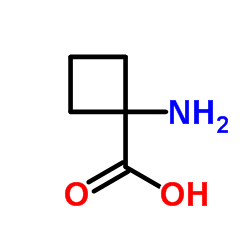1-Aminocyclobutanecarboxylic acid

1-Aminocyclobutanecarboxylic acid structure
|
Common Name | 1-Aminocyclobutanecarboxylic acid | ||
|---|---|---|---|---|
| CAS Number | 22264-50-2 | Molecular Weight | 115.131 | |
| Density | 1.3±0.1 g/cm3 | Boiling Point | 241.1±23.0 °C at 760 mmHg | |
| Molecular Formula | C5H9NO2 | Melting Point | 261ºC (dec.) | |
| MSDS | Chinese USA | Flash Point | 99.6±22.6 °C | |
| Symbol |

GHS07 |
Signal Word | Warning | |
|
[Change in the level of 1-aminochloropropane-1-carbonic acid. Activity of a protein inhibitor of polygalacturonase, intensity of formation of oligouronides in apples during ripening and treatment with haloethane derivatives and aminoethoxyvinylglycine].
Prikl. Biokhim. Mikrobiol. 39(4) , 461-4, (2003) We studied changes in the intensity of ethylene release and accumulation of 1-aminocyclopropane-1-carboxylic acid during ripening of two apple varieties characterized by various physiological states and treated with halothane derivatives and L-alpha-(2-aminoe... |
|
|
Glycine antagonist action of 1-aminocyclobutane-1-carboxylate (ACBC) in Xenopus oocytes injected with rat brain mRNA.
Eur. J. Pharmacol. 167(2) , 291-4, (1989) ACBC has been reported to have the binding profile of an antagonist at the glycine site of the NMDA receptor. In Xenopus oocytes injected with rat brain mRNA, we have confirmed the antagonist action of ACBC on NMDA responses. ACBC and HA-966, a known glycine ... |
|
|
Ethylene biosynthesis: processing of a substrate analog supports a radical mechanism for the ethylene-forming enzyme.
Chem. Biol. 5(1) , 49-57, (1998) The chemical mechanism of the final step of ethylene biosynthesis (the conversion of 1-aminocyclopropanecarboxylic acid, ACC, to ethylene by ACC oxidase, the ethylene-forming enzyme, EFE) is poorly understood. Two possibilities have been suggested: a radical ... |
|
|
Dietary N-3 fatty acids inhibit ischaemic and excitotoxic brain damage in the rat.
Brain Res. Bull. 32(3) , 223-6, (1993) Arachidonic acid [20:4(N-6)] has been implicated in neurological damage induced by cerebral ischaemia. Membrane arachidonate concentrations can be reduced by changes in dietary fat intake. Therefore, in the present study, we have investigated the effects of N... |
|
|
1-aminocyclobutane[11C]carboxylic acid, a potential tumor-seeking agent.
J. Nucl. Med. 20(10) , 1055-61, (1979) 1-Aminocyclobutane[14C]carboxylic acid [C-14) ACBC] was incorporated preferentially by several tumor types in rats and hamsters. The agent was cleared rapidly from rat blood, attaining its maximum tissue concentrations within 30 min after i.v. injection. Carr... |
|
|
Tumor detection with 1-aminocyclopentane and 1-aminocyclobutane C-11-carboxylic acid using positron emission computerized tomography.
Clin. Nucl. Med. 6(6) , 249-52, (1981) Eight patients with proven or suspected neoplastic lesions were examined with 1-aminocyclobutane C-11-carboxylic acid and 1-aminocyclopentane C-11-carboxylic acid using positron emission computed tomography. The results of this comparative study have shown th... |
|
|
Mechanism of partial agonist action at the NR1 subunit of NMDA receptors.
Neuron 47(1) , 71-84, (2005) Partial agonists produce submaximal activation of ligand-gated ion channels. To address the question of partial agonist action at the NR1 subunit of the NMDA receptor, we performed crystallographic and electrophysiological studies with 1-aminocyclopropane-1-c... |
|
|
Inhibition by 1-aminocyclobutane-1-carboxylate of the activity of 1-aminocyclopropane-1-carboxylate oxidase obtained from senescing petals of carnation (Dianthus caryophyllus L.) flowers.
Plant Cell Physiol. 38(3) , 312-8, (1997) We partially purified 1-aminocyclopropane-1-carboxylate (ACC) oxidase from senescing petals of carnation (Dianthus caryophyllus L. cv. Nora) flowers and investigated its general characteristics, and, in particular, the inhibition of its activity by ACC analog... |
|
|
Evidence for a functional coupling of the NMDA and glycine recognition sites in synaptic plasma membranes.
Eur. J. Pharmacol. 188(1) , 63-70, (1990) Activation of the N-methyl-D-aspartate (NMDA) receptor complex is subject to modulation via interactions at a coupled [3H]glycine recognition site in rat brain synaptic plasma membranes (SPM). We examined the effect of the potent and specific glycine site ant... |
|
|
Pharmacological characteristics of cyclic homologues of glycine at the N-methyl-D-aspartate receptor-associated glycine site.
Neuropharmacology 29(8) , 727-30, (1990) In Xenopus oocytes, injected with mRNA from the brain of the rat, the characteristics of the cyclic homologues of glycine, ACPC, ACBC and cycloleucine have been examined. 1-Aminocyclopropane-1-carboxylate was a potent agonist at the NMDA-associated glycine si... |